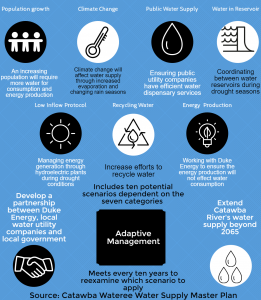The Catawba River flows for two hundred and twenty miles between North and South Carolina and provides water, energy, and supports industries like agriculture for two million people. As the population around the Catawba-Wateree basin exploded, the local governments, utility companies, and Duke Energy became concern about the longevity of this critical source of water. In 2006, Duke Energy published a report as part of their hydroelectric re licensing requirements to calculate how much water the increased population will require. Other water management experts also took interest in calculating the future of Catawba River.
One of them is the Catawba-Wateree Water Management Group who published the Water Supply Master Plan. This plan is unique for several reasons. First, Duke Energy, which has a near-monopoly on the energy production in the state of North Carolina and parts of South Carolina, closely monitors the water level throughout the eleven reservoirs in the basin. This allows the for-profit company to manage most of the monitoring cost instead of having the smaller water utility company and local government pay for it. The second is the partnership that Duke Energy and the different stakeholders have to manage the water in the basin. Instead of an antagonistic or neutral relationship, these different stakeholders are working closely to ensure each other’s future success. Finally, the plan is written by a third-party organization (the Management Group) and employ the assistance of nineteen other stakeholders to make sure all relevant voices are heard. The list of nineteen includes counties’ council of governments, three marine commissions, the two states department of natural resource and environmental control, the re licensing coalition, conservation fund, and local paper mills.
The plan itself uses adaptive management and models the current inflow and outflow of the river. The current usage of the water is split between power generation, industrial, public water, and agriculture. Since power generation and public water usage is responsible for over ninety percent of the water’s withdrawal, it is critical for Duke Energy and the utility companies to agree on how the river flows. A few of the categories that are involved in the model include climate change, population growth, the water level in the different reservoirs, having more effective water recycling strategies, and power generation. Climate change, for example, threatens the quantity of water by having increased evaporation in warmer temperatures and changing the rain pattern which can reduce the amount of water going back to the basin.
With these categories, the management group developed and is encouraging the various local stakeholders to apply plan MP-01Mb Mitigated Planning Case B. This plan is built with the hope that the water utility companies uses efficient water providing strategies, that there is lower water intake in the upper basin (Hickory, Long View, Valdese), Lake Norman, and Lake Wylie, recognize that there will be higher intake in Mountain Island Lake, and to raise the water level by six inches in Lake James, Lake Norman, and Lake Wylie. If these changes are implemented, the plan estimates that the total water withdrawal will increase from 189 millions of gallon per day to 419 millions of gallon per day by 2065, representing a 122 percent increase or 1.49 percent increase.
While this version of the plan is not perfect in assessing every stakeholders nor considers every potential worse-case scenarios, the adaptive management element of this plan allows it to be flexible and suggest different strategies if the worse case scenarios occur. The current plan of the organization is to encourage the necessary stakeholders to do their part in the plan, whether it is Duke Energy’s job to increase or lower the water level in the different reservoirs or the utility company’s job to reduce water waste in their distribution strategy, and to meet as a group to reassess the plan every ten years.
Source:
